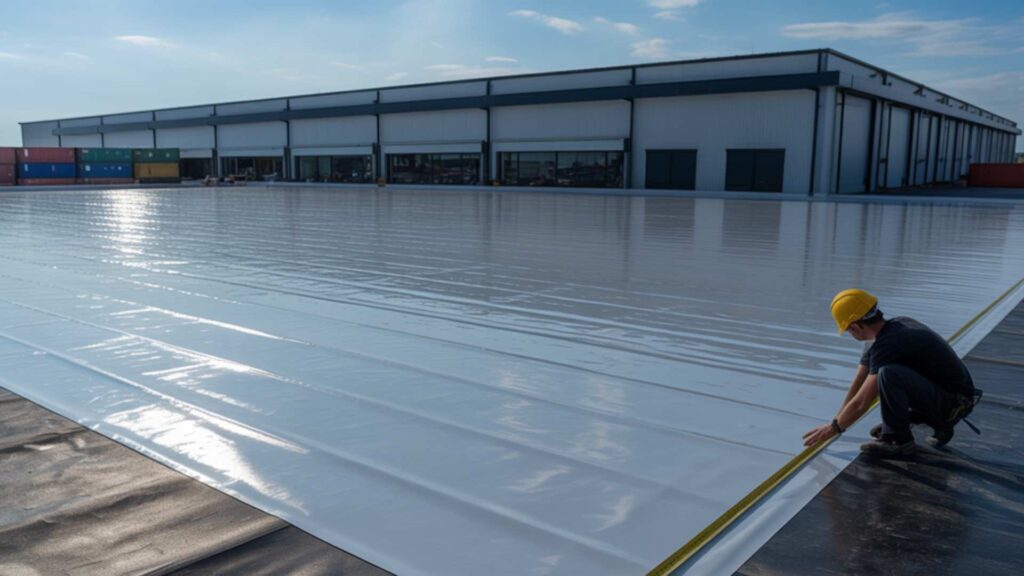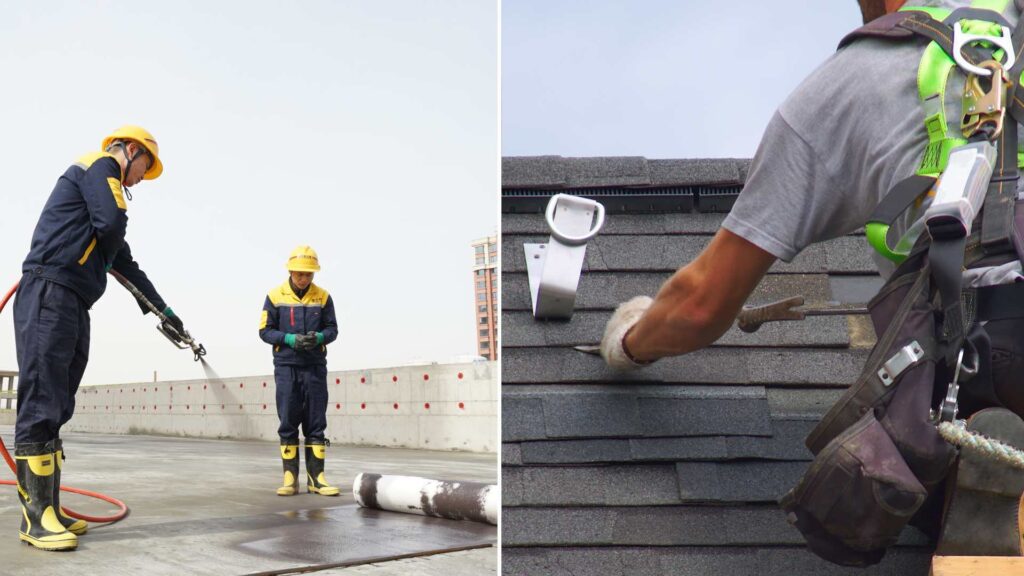Warehouse waterproofing cost in Dubai is a crucial consideration for any business owner looking to protect their assets and optimize their operational efficiency in this demanding climate.
Dubai’s unique weather, characterized by intense heat, relentless solar radiation, airborne saline dust, and unpredictable, heavy rainfall, puts extraordinary stress on building materials.
This makes warehouse roofs, often flat or low-sloped, particularly vulnerable to degradation and hidden moisture buildup.
Over time, untreated roofs inevitably develop cracks, leaks, and thermal damage.
These issues don’t just compromise your building’s insulation; they disrupt operations, damage inventory, and lead to increasingly expensive repairs.
Investing in a professionally applied waterproofing system creates a durable, protective membrane that significantly extends your roof’s lifespan, safeguards your internal environment, and drastically reduces the risk of costly water damage.
This blog will provide a clear breakdown of how the waterproofing process works, what you can typically expect in terms of cost in the Dubai market (ranging from AED 45-175 per sqm depending on the system and complexity), and the substantial return on investment (ROI) it delivers over time through decreased maintenance expenses, improved energy performance, and comprehensive asset protection.
This blog helps you to learn everything about warehouse waterproofing costs and its process in Dubai
Table of Contents
Why Waterproofing is Critical for Warehouses in Dubai
The environmental stress on warehouses in the UAE is constant. Flat or low-slope roofs, often built with concrete slabs or metal sheeting, are vulnerable to moisture retention and surface breakdown.
High daytime temperatures followed by rapid night cooling cause expansion and contraction, weakening joints and sealants over time.
When sudden rainfall occurs, water seeps into hairline cracks, accelerates corrosion, and causes internal dampness.
In industrial storage and logistics, even minor leakage can lead to equipment issues, product spoilage, or shutdowns during peak operations.
Waterproofing systems are designed to address these risks by forming a sealed, weather-resistant layer that blocks water ingress and helps maintain roof performance under shifting thermal loads.
Step-by-Step: Warehouse Roof Waterproofing Process
The waterproofing method varies based on roof type, surface condition, and usage. Durra Group follows a structured application process to ensure long-term durability and membrane integrity.
1. Site Evaluation and Roof Inspection
The process starts with a full assessment of the roof. Technicians check for cracks, water pooling, surface wear, poor drainage, rusted joints, and existing patch repairs. They identify substrate type (metal or concrete) and select the appropriate system based on slope, exposure, and roof function.
2. Surface Preparation
Before any application, the surface is cleaned and leveled. All dust, oil, corrosion, and loose materials are removed using mechanical scrubbing or pressure washing.
On metal roofs, rusted panels are treated. On concrete, cracks are repaired with compatible sealants or fillers to create a uniform surface.
3. Primer Application
A primer coat is applied to improve membrane bonding.
The primer also stabilizes the roof surface, ensuring the waterproofing layer adheres uniformly and resists peeling or blistering over time.
Primers are selected based on compatibility with the membrane and substrate material.
4. Membrane Installation
Durra Group applies different membrane systems depending on the structural requirements:
- Liquid-Applied Waterproofing (PU or Acrylic): Offers seamless coverage with flexibility. Suitable for roofs with complex geometries or penetrations like HVAC mounts.
- Bituminous Membranes (Torch-Applied): Durable and UV-resistant. Commonly used on flat concrete roofs.
- Self-Adhesive or Peel-and-Stick Membranes: Quick to apply on even surfaces with minimal detailing.
Multiple coats may be applied with mesh reinforcement at expansion joints, corners, and edges for added strength.
5. Detailing and Edge Finishing
Critical points such as outlets, flashings, upstands, and joint lines are sealed with reinforced mesh or specialized detailing compounds. This ensures that water cannot enter through gaps around roof fixtures or drainage channels.
6. Final Inspection and Quality Testing
Post-application, the roof is inspected for coating uniformity, edge bonding, and membrane thickness. Optional water ponding or spray tests may be conducted to ensure leak protection. A warranty document is issued based on the system installed and the maintenance plan agreed upon.
Waterproofing Cost in Dubai: Typical Price Ranges
Waterproofing cost varies by material type, membrane thickness, surface condition, and roof size. The following are average price ranges in the Dubai industrial market (as of 2025):
System Type | Roof Material | Estimated Cost (AED/m²) |
PU or Acrylic Liquid Coating | Concrete or Metal | 30 – 45 |
Bitumen Membrane | Concrete Slab | 25 – 35 |
Hybrid Reinforced Systems | Complex Roofs | 50+ |
Self-Adhesive Membranes | Smooth Concrete | 35 – 40 |
These rates typically include materials, labor, preparation, and warranty-backed application. Prices may vary depending on roof accessibility, height, detailing work, and required curing times.
Long-Term ROI of Warehouse Roof Waterproofing
Investing in waterproofing contributes to lifecycle cost reduction and uninterrupted operations. Here are the key areas where return on investment becomes measurable:
Lower Maintenance Frequency
Waterproofed roofs experience fewer leaks, fewer emergency patch jobs, and less internal water damage. This reduces recurring repair costs and reactive maintenance cycles.
Inventory and Equipment Protection
By preventing seepage, waterproofing safeguards goods, pallets, and machinery from water exposure. This is essential in storage units dealing with electronics, perishables, or packaged goods.
Improved Energy Efficiency
Some coatings also reflect UV rays and reduce heat gain. This supports indoor temperature regulation, easing HVAC loads and helping reduce energy costs in summer months.
Extended Roof Life
High-quality waterproofing can extend the roof’s functional lifespan by 10–15 years, delaying the need for full roof replacement or structural reinforcement.
Regulatory and Insurance Benefits
Well-maintained and waterproofed roofs meet safety standards more easily and may help qualify for better insurance coverage or lower premiums.
Choosing the Right Waterproofing Partner
The success of waterproofing lies in both the material and its application. Dura Altaj Contracting’s waterproofing solutions are designed for Dubai’s climate, warehouse construction types, and operational needs.
Every project is backed by site-specific planning, an expert workforce, and high-performance materials sourced from trusted suppliers.
Durra Group offers:
- On-site consultation and technical roof audits
- System design tailored to roof type and industry requirements
- Trained applicators and certified materials
- Post-installation inspections and long-term service agreements
Conclusion
Waterproofing plays a vital role in protecting warehouse assets and preserving roof structures in Dubai’s demanding conditions. With a structured process, proper materials, and expert execution, it offers measurable operational and financial benefits over time.
Dura Altaj Contracting LLC delivers waterproofing systems that match industrial performance standards with regional experience, ensuring that your warehouse roof remains protected, durable, and ready for every season.
Ready to Waterproof Your Warehouse Roof?
Contact us now to get expert guidance, premium materials, and long-term protection tailored for Dubai’s industrial conditions. We provide fully managed waterproofing services for warehouses, logistics hubs, and storage facilities across the UAE.



